This year marked the greatest gathering of human beings in history—660 million congregating at the confluence of the Ganga and Yamuna. Dev Raj Agarwal walks us through the Mela with him, and gathers insights from saints and renunciates on Hindu matters. Ellen Coon focuses on women pilgrims’ experiences with the sacred bath in Mother Ganga’s lap and meeting holy ones.
By Dev Raj Agarwal, from Prayag
The Kumbh Mela is a festival that unites people. Differences of caste, creed, social status and religious affinities are forgotten when all walk through the crowd, jostling to keep family members together. Millions congregated this year in a small area of 25 square miles for that magical dip in the water at the confluence of the holy Ganga, Yamuna and the hidden Saraswati rivers. This dip brings forth sublime joy, spiritual contentment, realization and new confidence to the devout.
The festival lasted from January 13 to February 26, 2025. It was aptly called the Mahakumbh, the grandest of all the Kumbh Melas, held on a special celestial configuration that occurs every 144 years. The near-seamless management of the challenges of stay, food and sanitation for such crowds became an international inspiration. The world also noted the exemplary behavior of the pilgrims. There were no tussles or fights, no robberies or snatching of belongings.
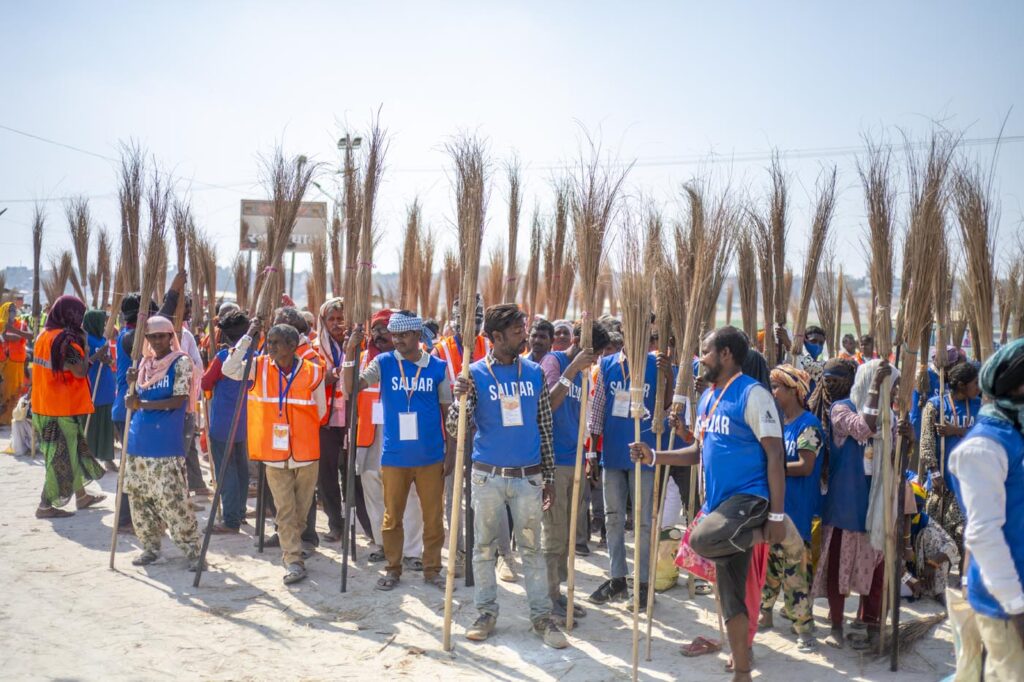
For me, participating in the Mela was an opportunity to test my physical and mental endurance for seven days.
Pilgrims to Prayag
Pilgrims poured into the area 24 hours a day, their numbers surpassing all expectations of the organizers. When the crowd swelled beyond the limits of control, incoming pilgrims were stopped well before the city limits. Trains were canceled along with confirmed reservations, and road traffic was blocked miles before Prayagraj city.
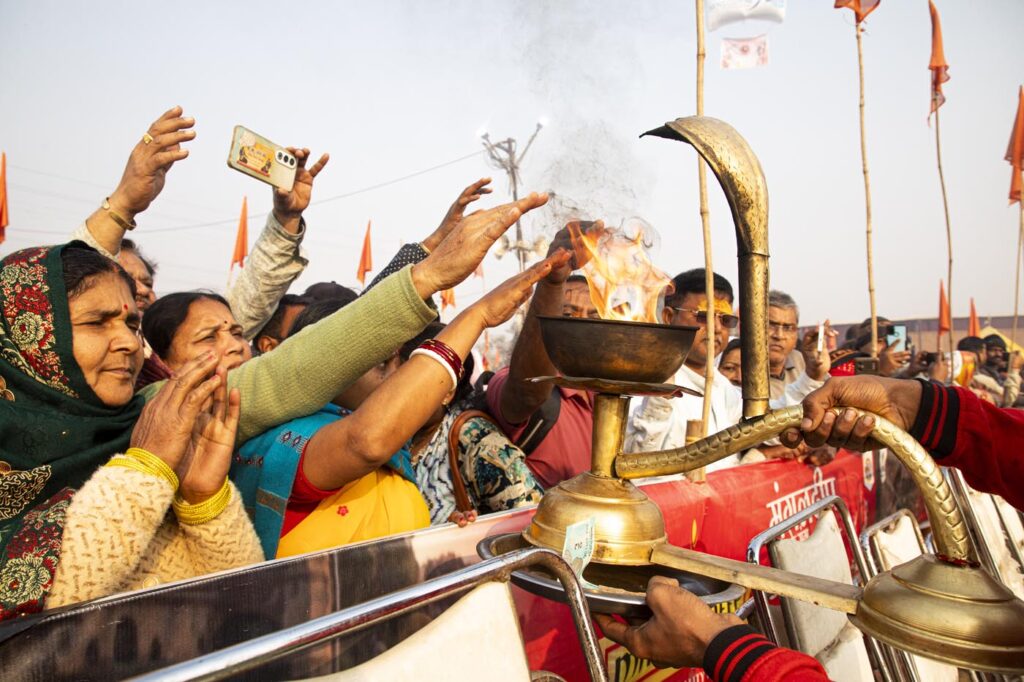
Pilgrims had to walk long distances to reach the Sangam, the meeting point of the three rivers, but none seemed bothered in the least. They came in large families—men, women, small children and even grandparents. Poorer ones carried their belongings in plastic trash bags. Elders walked briskly but cautiously, staying together in the crowd with the help of a saree used as a rope.
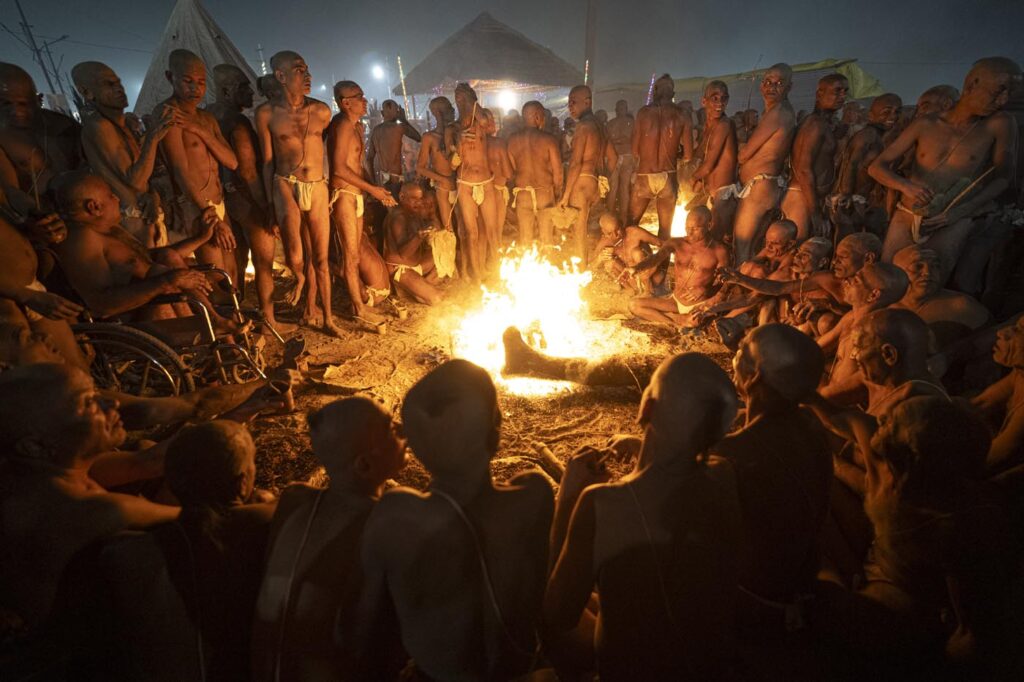
People coming from afar had to spend at least one night in Prayagraj. The Jan Aashray Sthal tent city, set up in different parts of the Mela, could only house a tiny fraction of the influx. Hotels in Prayag were a luxury, and festival-time tariffs were high. As a result, many spent the night by the road or on the riverbank.
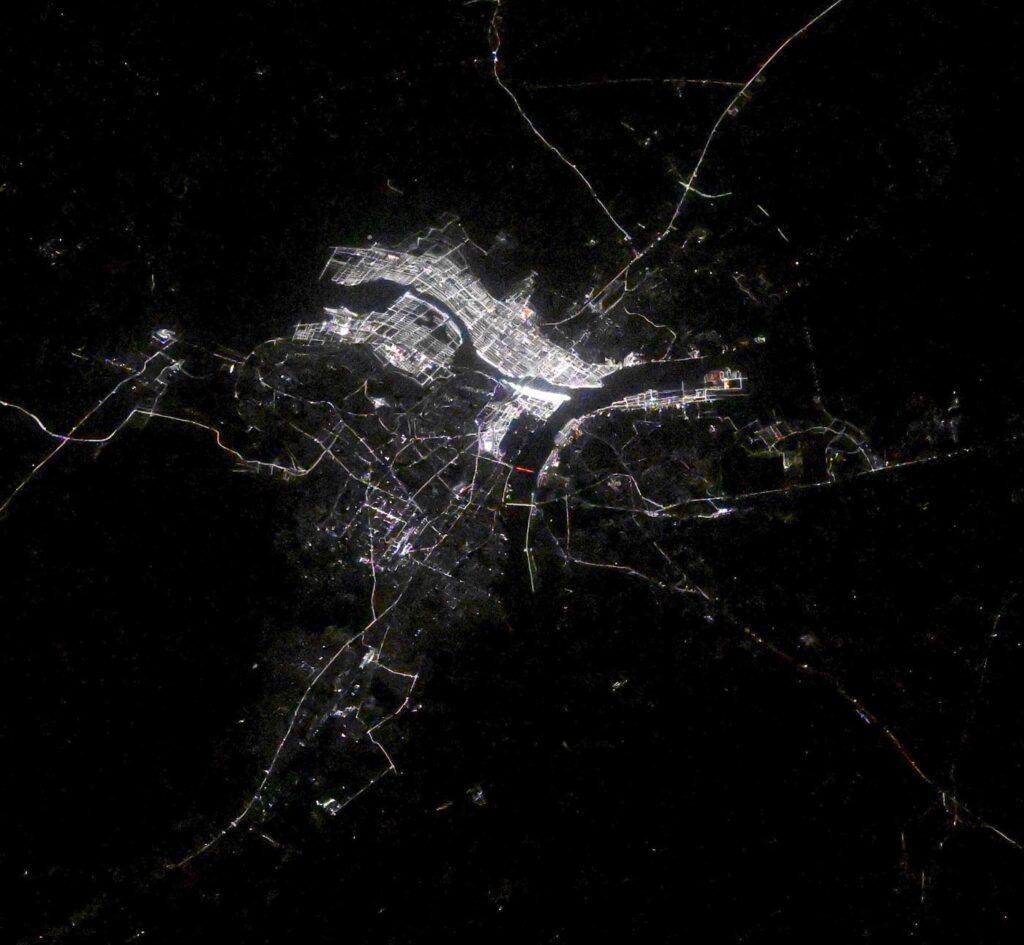
Nothing is wasted in India. Large printed plastic sheets about five feet square, discarded from the packaging industry, were sold in the Mela for 23 cents for use as bed sheets.
All pilgrims had one extra item to carry on their return journey—the pot containing Gangajal, Ganga water. Come what may, they must maintain its sanctity as they made their way back home. The plastic jerrycan for sacred Ganga water was the most-sold item in the Mela.
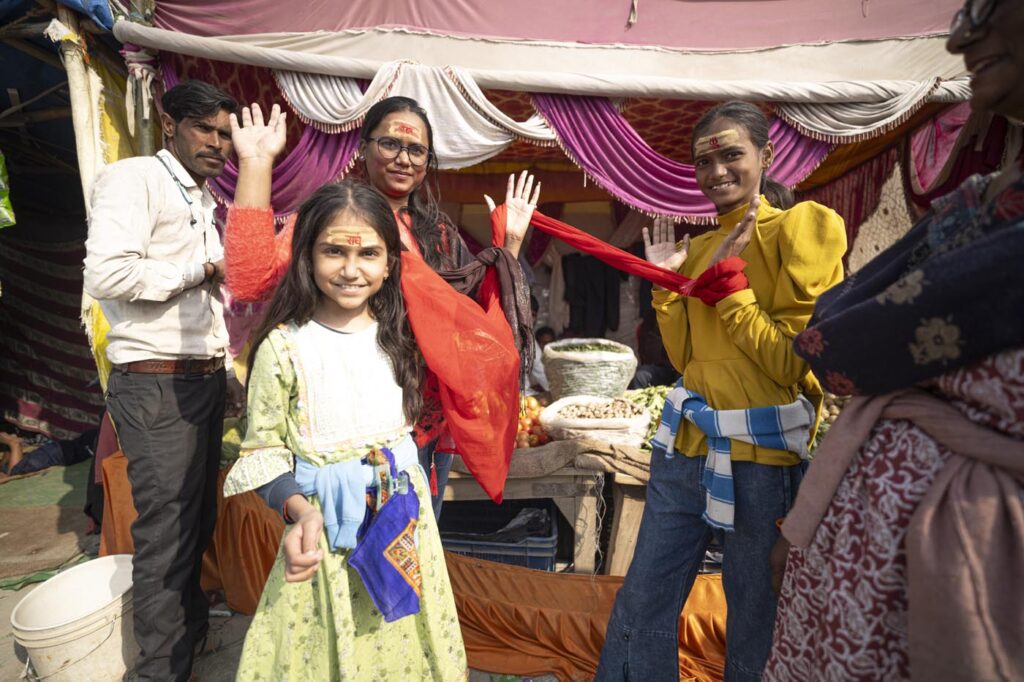
One could not miss groups of Kalpavasis camping in the Mela area. These are extra-serious pilgrims who spend more time in the Mela, with rituals, pujas, meditation, listening to discourses and eating little. It is the simplest kind of penance and detoxification of body and mind. They slept on straw mats, cooked their own food and spoke little. I was overwhelmed by the simplicity and dedication of a group of Kalpavasis from Nepal wearing yellow dhotis.
Many pilgrims visited the akharas, monastic orders, in the camp area across the Ganga. They sought darshan of saints and sadhus, especially the Nagas in Saiva akharas. Some Naga sadhus wore fancy sunglasses, and carried a mobile phone as their inseparable tool. Tall headdresses, often made of rudraksha beads, seemed to be the in thing.
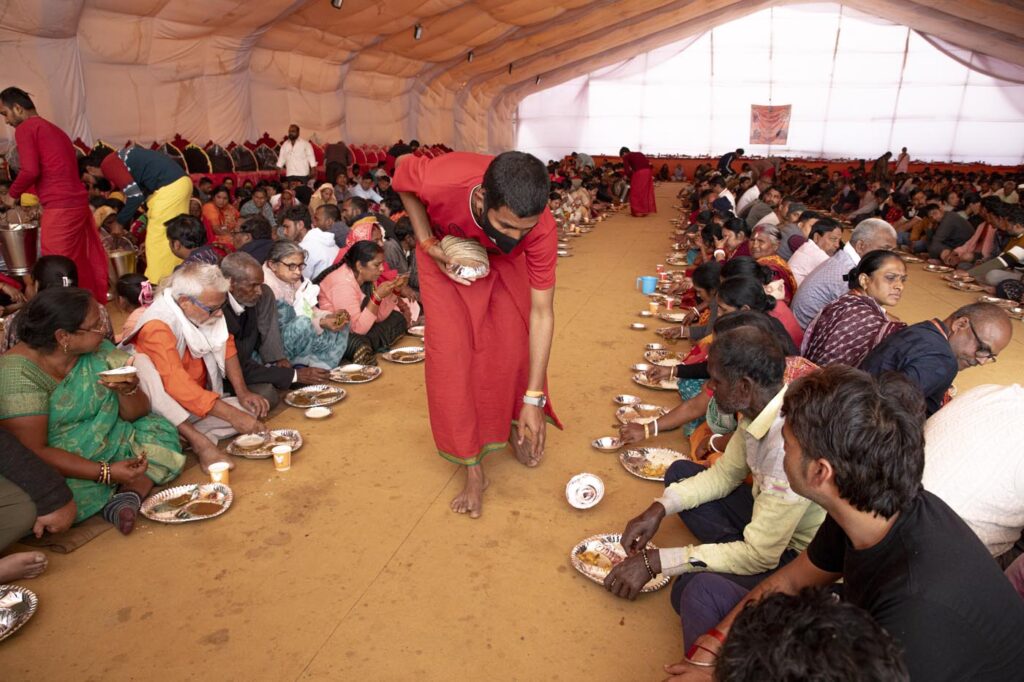
Affluent people, mostly disciples of gurus, preferred to stay at the akhara camps, where they could join service programs and attend discourses and kathas by saints. There was a noticeable increase in the number of foreign visitors at this Mela, as Westerners increasingly want to learn about Hinduism.
Pushpender Mehra and his family from Jaipur spent two hours on the left bank of the Ganga across from the Sangam. I watched the group taking utmost care in performing rituals on the water. “We left home four days ago, had a holy dip in Haridwar and then darshan of Kashi Vishvanath in Varanasi,” related Pushpender. “Then we came here. We offered clothes to Ganga Mata. We are 120 people in buses, one big family. Our objective was not to wish for anything but to appease our Devis, Devatas and forefathers by offering a small puja in their names.”
Times are changing. The younger generation is developing an interest in spirituality and following traditions of the family, becoming health conscious and trying to understand what the wise men say. This was evident from the wholehearted participation of youth in the bathing rituals at the ghat. Chhavi, 22, an MBA student, rushed to the ghat with her family for a bath. “Is the younger generation of Hindus going away from their traditions and rituals?” I asked her. “No, I don’t think so. We take part in all religious activities of our family.” Chhavi’s two cousins had the same views. They were anxious to take a dip.
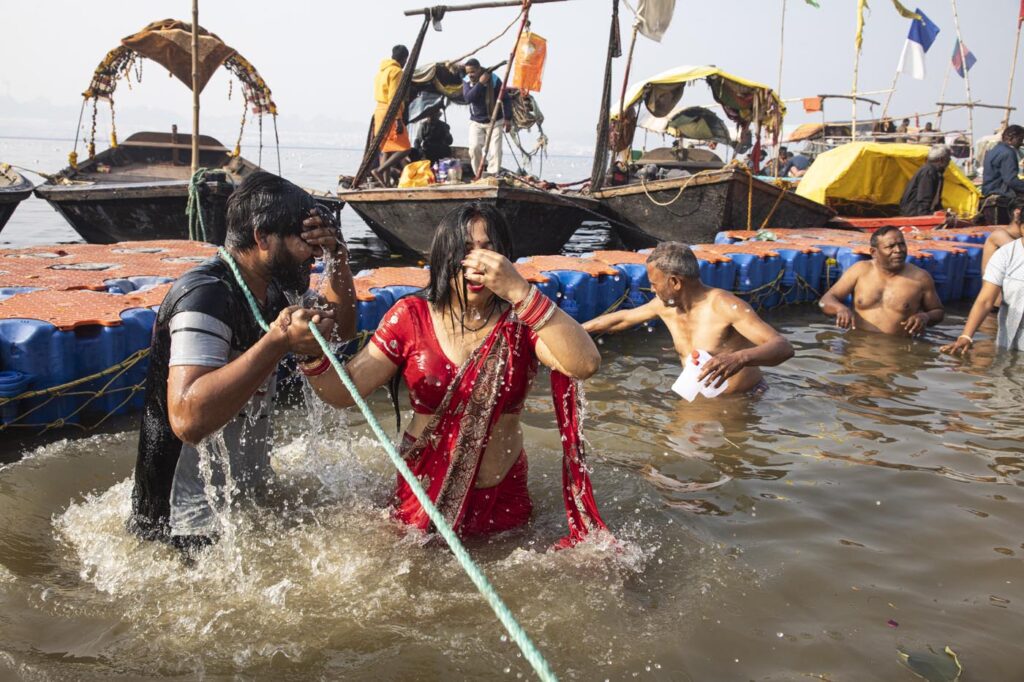
It was the first time to Prayagraj for Rishabh and Shilpi Shukla from Sitapur. They were almost in tears, overwhelmed by the divine feeling after their dip in the Ganga. “We had heard and watched so much about the Mahakumbh and wanted to see it for ourselves,” they said. To them it mattered little having to walk three miles for the bath. They looked like a blessed couple, with beaming foreheads and benign smiles.
The influx of pilgrims remained undaunted even after a deadly stampede on January 29, but most people then avoided staying in Prayag itself. Itineraries were revised. Destinations like Ayodhya and Varanasi were added to new pilgrimage plans. It made sense for some to park vehicles as far as forty miles away and take public transport to Prayag.
Saintsí Guidance for Pilgrims
I asked some of the saints what a devotee should do on a pilgrimage and after returning home. Yogi Sheel Nath of Adinath Akhara opined, “Once home, he should organize a feast for his relatives and friends. The pilgrim should try to leave all durguna (bad habits, demerits) here in Ganga. It’s a celestial event that affects the entire universe. Whatever punya we do, it reaches the param paramatma. We should come to an event like a sahayogi (helper) and not as a badhak (obstructor).”
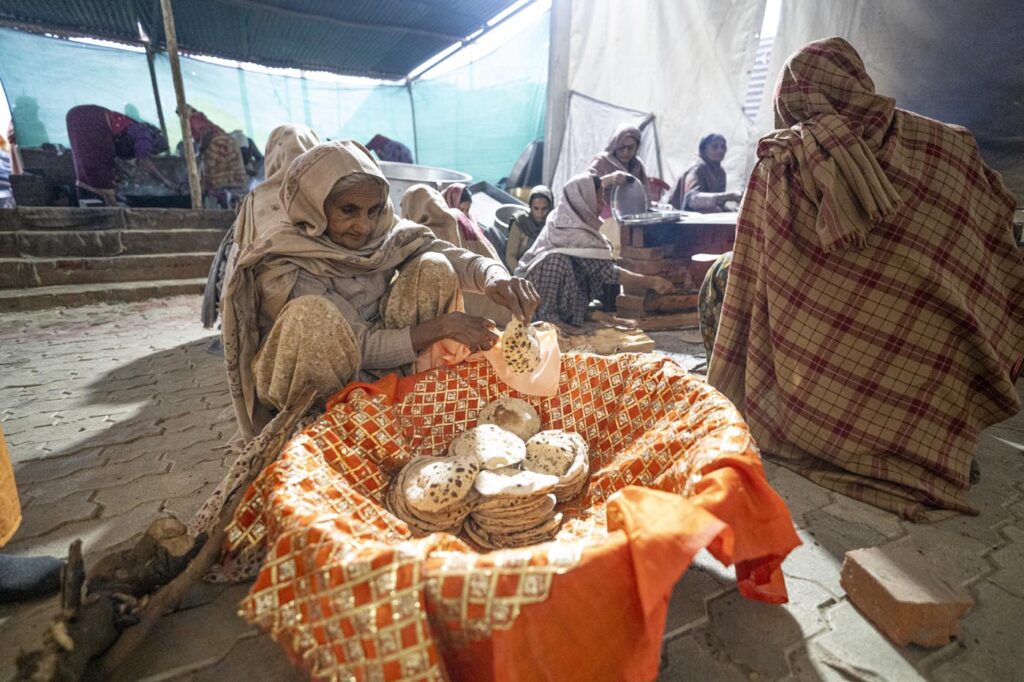
According to Ma Santoshi Mata, “The humblest pilgrims have a main goal, the holy bath, followed by darshan of saints. They carry belongings on their heads. Such pilgrims are the real form of dharma. No yatra is a real yatra without ordeals. We must feed them, look after them, welcome them. We must also alert pilgrims to infiltration by fake saints.”
Food, Hygiene and Health
Free food was served to millions of pilgrims by camps of akharas, individual saints and by large corporations. The number of people fed depended on the size and financial ability of the camp. Some had dining space inside, while others served food by the road. Pilgrims could freely enter any camp for meals. Eating in the huge dining tent of Niranjani Akhara was a great experience for me. The tent accommodated about five hundred people at a time. The food quality was comparable to an expensive vegetarian restaurant. With a staff of 180, they fed 25,000 pilgrims on each of the busiest days and 10,000 on other days.
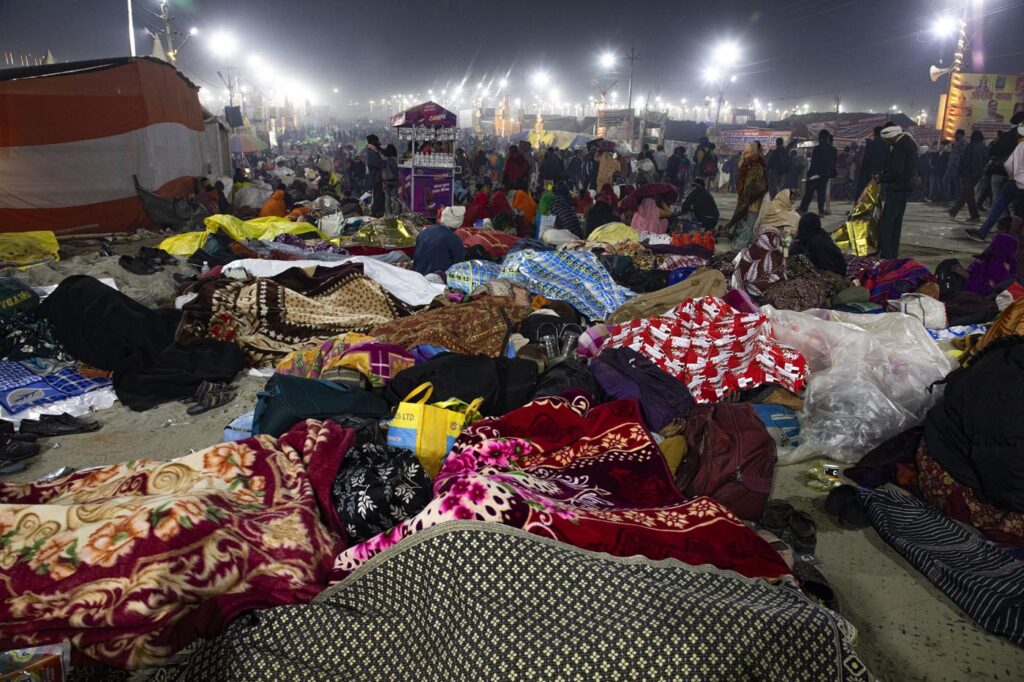
I asked Mahamandaleshwar Ravindra Puri of Niranjani Akhara how they managed their mega kitchen. “We are trying to offer seva to the society. People are here from all walks of life, from north to south. Many do not have arrangements to spend the night, as they cannot spend 20,000 rupees on a dingy room. We offer them shelter and food. Although space in the camp is limited, we try to accommodate as many people as possible.”
How did they assess the amount of food to prepare? “We go outside the camp and ascertain the thickness of the crowd on the road. This helps us decide how much food to prepare on a particular day. We have hired professional cooks. Our effort is to offer very tasty and hygienic food to the visitors.”
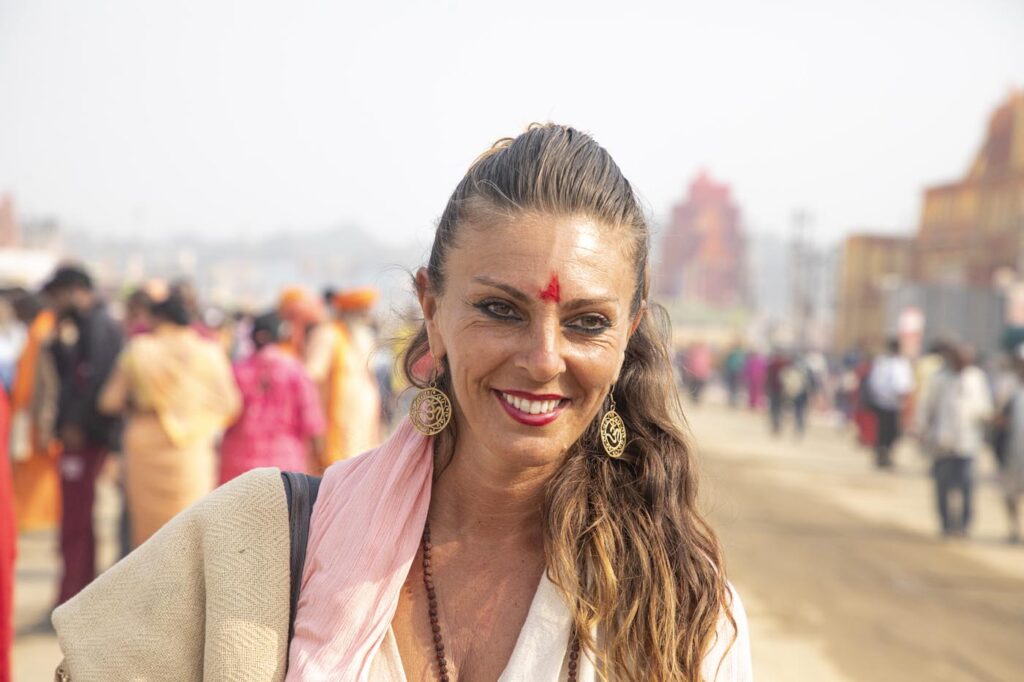
Himmat Singh was part of a 100-strong pilgrim group from Himachal Pradesh that ran a roadside kitchen outside Juna Akhara, serving food to thousands of passersby every day. The best seva, Himmat and his team said, was feeding hungry pilgrims who were unable to buy food in the Mela area. It was the duty of men to prepare and serve food while women prepared rotis on a large hot plate. It was heartening to see pilgrims feasting on rotis made of corn flour, very popular in Himachal Pradesh.
Cleanliness was a major focus of the Mela. Huge dustbins were spaced every 250 feet. There were no flies, monkeys or stray dogs. Volunteers with long-handled brooms cleaned the roads frequently. An astonishing 150,000 toilets were cleverly hidden behind the streets of the Mela area, and these were cleaned and refreshed twice a day. Filtered drinking water was provided through vending machines for free. A large number of hospitals and dispensaries were always ready for ailing or injured pilgrims.
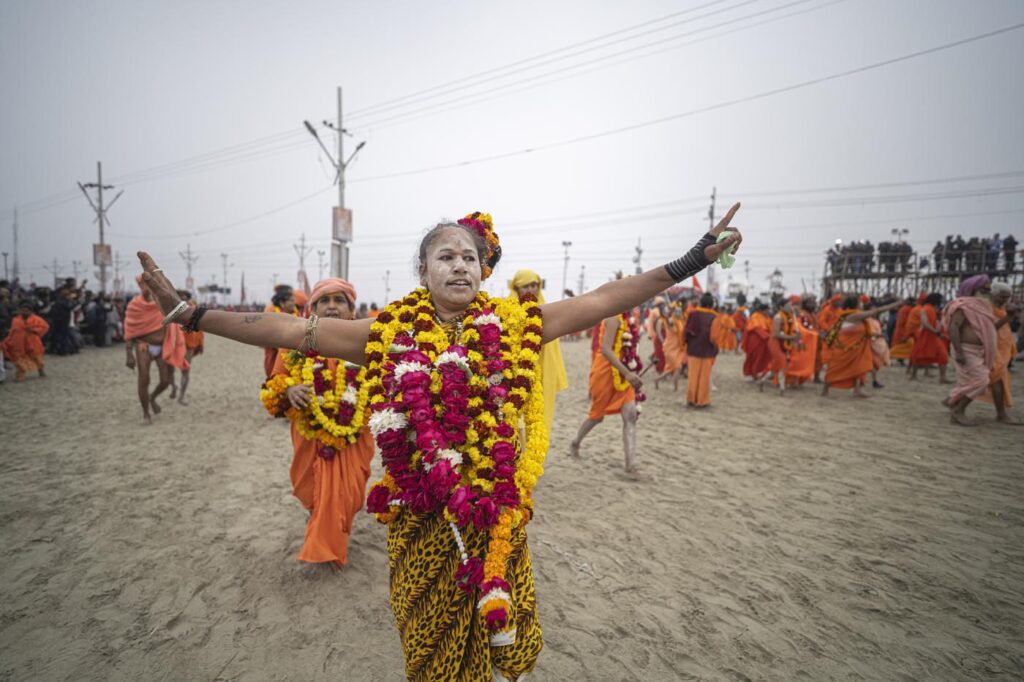
Crowd Management
Managing surges and safety was of prime importance for the organizers of the Mela. Thousands of workers were involved. A crowd assessment team had 1,800 CCTV cameras. Crowd density was assessed with the help of AI techniques and drone images. Additionally, there were 744 cameras with 360-degree view. The Mela area had 211 police posts. But despite all efforts, several dozen died in a pre-dawn stampede on January 29, the most auspicious day for bathing.
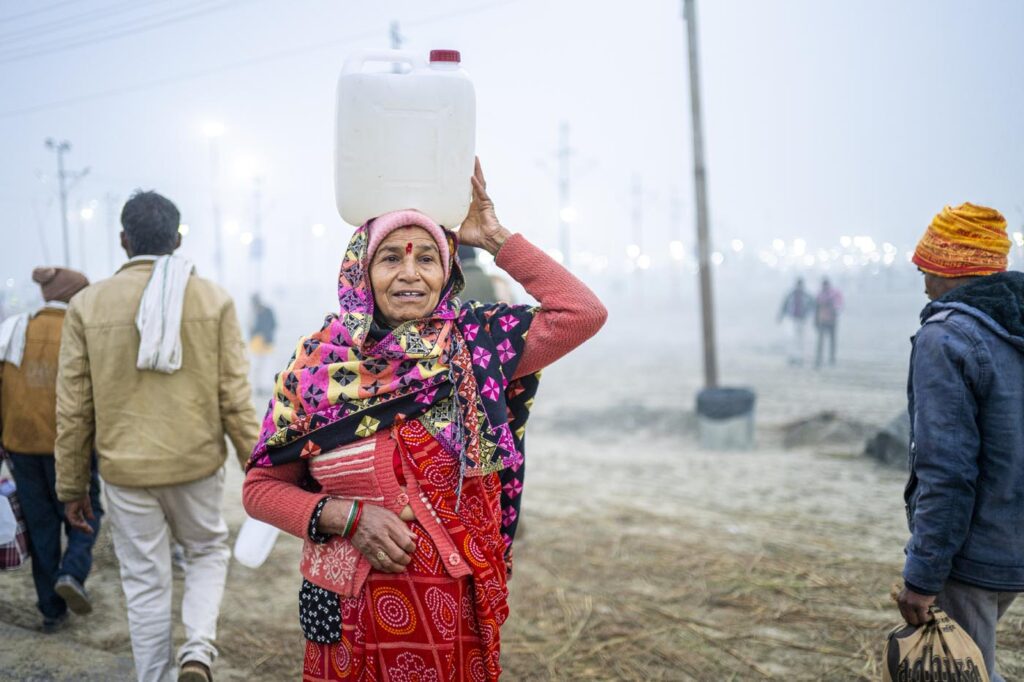
Bharat Scouts and Guides established their camp in Mahakumbh with 5,000 young Scouts, Guides, Rovers and Rangers deployed to help the police and workers. According to Lalita Pandey, State Commissioner of Scouts and Guides, the Scouts returned more than 300 smartphones to the police from the site of the stampede.
Booths constantly announced people who got separated from family members. Numbers had been painted on all electric poles in the Mela, and these poles became meeting points. Sachin Tiwari, working at one of the ten lost-and-found centers, told me, “Information and pictures of a lost person are fed into the AI-assisted computers. Sector-specific data makes it much easier to look for the lost person in a limited area.”
Early on in the Mela, people often had to walk many extra miles because bridges were suddenly closed for VIPs and their families entering the Mela in big cars with horns blaring. This was perhaps the only show of social disparity in the festival of unity. After a few incidences of reaction from the frustrated public, the administration stopped entry of VIP vehicles.
After weaving through thick crowds to reach a bathing spot, many pilgrims proceeded to quieter areas for darshan of thousands of saints, yogis and scholars gathered for the mega event. I took the opportunity to meet some of the saints to ask for their views on this Mela, dharma, spirituality and the future of Hinduism. Excerpts are on the following pages.
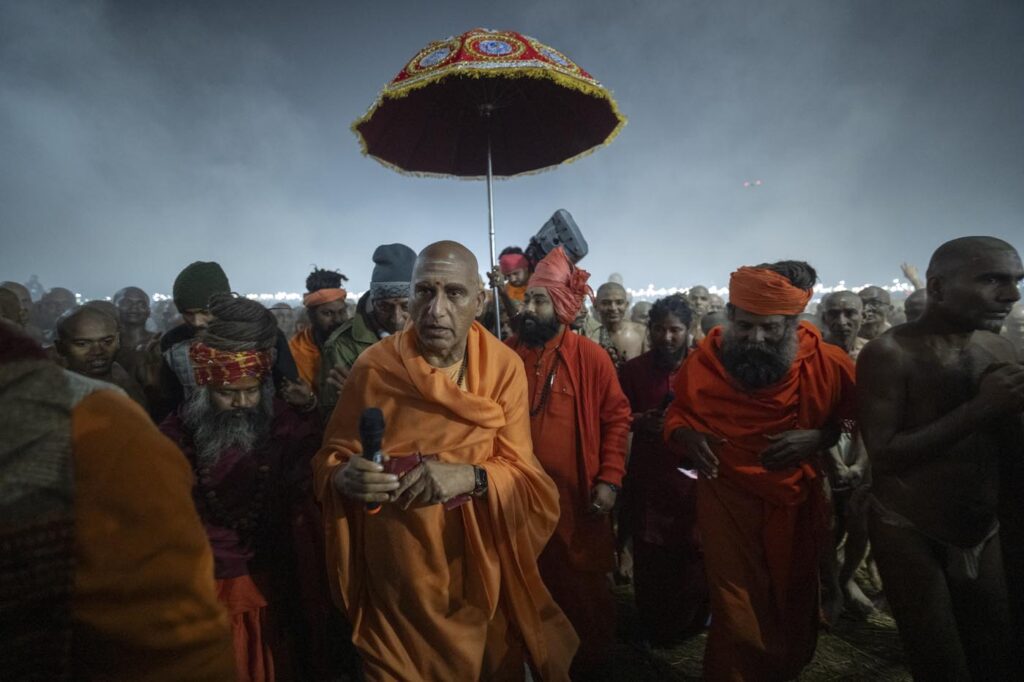
Interviewing Saints & Renunciates at the Kumbh
Significance of 2025 Kumbh Mela to the World
Swami Avdheshananda Giri, head of Shri Panchdashnam Juna Akhara: The Mahakumbh is a show of social harmony. From among millions taking a dip in the Ganga, no one was asking the other devotee about his caste or social status. The whole world watched in awe the unity of Bharat. The surge of millions, the congregation of saints and wise men and the smooth running of the grand show took the entire world by surprise. While some were present in the holy festival, others were watching the goings-on of the Mela from home. Many who could not attend earned the blessings of Ma Ganga anyway by taking a bath with a few drops of Gangajal added.
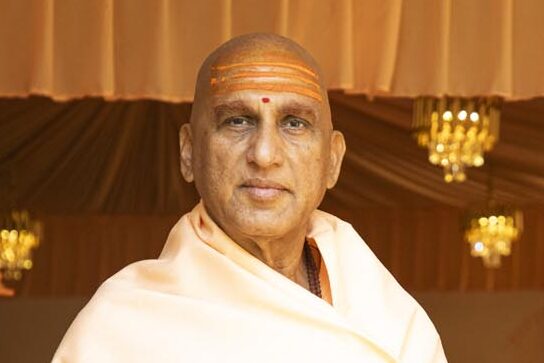
Foreign pilgrims were attracted to our dress, food, our graceful demeanor and discipline in a gathering of this enormity. There was food available for every person. No other nation can think of organizing an event with so many people. The number of pilgrims traveling in trains to the Mela was more than the entire population of Europe, all uninvited, without financial support from any agency, and totally unguarded. There were no helmets, no guns, no teargas shells. Policemen stood with folded hands, offering a helping hand to the old and sick or guiding people to take the right road. They were busy all the time.
Mahant Rajendra Das, President of Akhil Bhartiya Nirmohi Ani Akhara: Kumbh is associated with ancient traditions. It is the symbol of dharma, of our faith. Millions of devotees visit the places of Kumbh to drink the elixir of life during the special days of the Mela. We call it Amrut Kaal. It fills our heart and soul with new energy. Kumbh is the path to salvation. The present Kumbh is an example of universal brotherhood for the entire world. Millions of people visiting from the West come here as curious travelers but return home totally changed, forced to ponder what is so special about Hinduism.
Shri Mahant Bhardwaj Giri, chief secretary of Shri Panch Dashnam Avahan Akhara: Mahakumbh Mela is the biggest pageant of the political, cultural and religious system of India. According to the panchang calendar, there is a special yoga (time or moment) of the arrangement of planets when this place is filled with cosmic energy. Apart from millions of devout Hindus, there are many philosophers, thinkers, dharma gurus, saints and sages who are coming to Prayagraj at the time of the Mahakumbh to witness and understand the celestial event. There are many, especially Westerners, looking for saints, to seek advice from them, to find answers to their unsolved questions. They return home as content souls filled with peace and joy, with admiration for Hinduism and more faith and dedication to their guru. Our saints and dharma gurus have gained a lot of respect. Many feel that Hinduism is the only way to maintain world peace.
Yogi Sheel Nath, member of Adinath Akhara: Everyone taking a dip in the chilly Ganga water is equal—after all it is just the cold water for all, no special luxury for any one of them. Millions of devotees from all walks of life reach here, leaving behind the comforts of their homes. The most significant message from the Mahakumbh is universal brotherhood and world peace.
Swami Gyananand Ji Maharaj, Gita Gyan Sansthanam: The Sanatan faith has been well understood by the whole world from the Mahakumbh. People who raise questions on Hindu belief, who talk of disparities like those of caste and untouchability, saw that it was a dip of unity and dignity at Mahakumbh. There was no one to check the national identity cards of pilgrims. The participation of youth was proportionately high in the Mahakumbh. It is a very positive sign for the future of our dharma.
Role of Dharma in the Modern World
Swami Avdheshananda Giri: Dharma is the entity that holds the existence of mankind. It makes the present and future perfect and complete. Dharma makes us complete when we use truth, energy, capability and consciousness in our deeds. There are two kinds of things in the world; one is nashwar, transient, which will perish or which is subject to change. The only immortal thing is the atmatattva, the essential reality of the Self. The entity that introduces us to this truth is dharma. Dharma makes us realize what our duties are, what we should do.
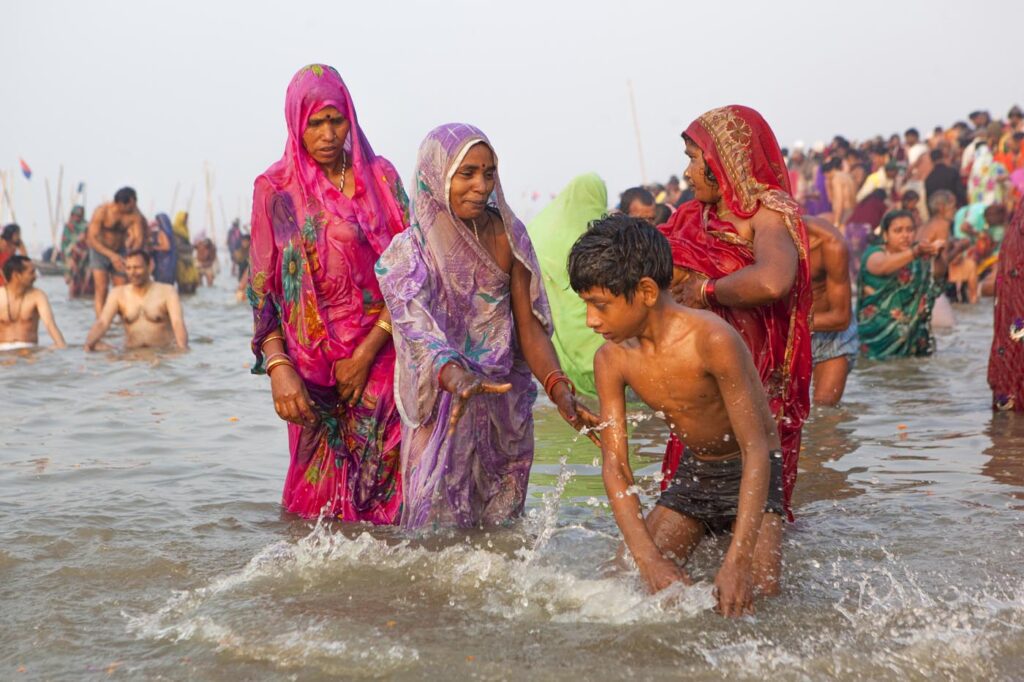
Shri Mahant Ravindra Puri, Niranjani Akhara: Our Prime Minister is taking Sanatana Dharma to new heights. He raised his voice in 2014. The youth before then did not have much interest in Sanatana Dharma; they criticized it and did not put tilak on their foreheads during pujas. They were reluctant to visit temples, criticized teachings and preachings of saints and gurus. There has been a noticeable change now. Today our younger generation has great interest in religion. They go to temples, follow rituals and feel proud to be Hindus. I see thousands of young men coming to Haridwar to formally wear yagnyopavit thread every month. We need to strengthen the gurukulam tradition to keep away from outside influences of all sorts.
Yogi Sheel Nath: Dharma means accepting or adopting creation. Our saints have kept dharma in forefront with this idea. We should respect our parents. We have mentioned the relations with each other like between husband and wife, father and son, daughter-in-law and mother-in-law. Nothing can move forward without love and affection towards all living beings. There is no use of the word “divorce” in Sanatana culture. The idea of divorce never rang true to us.
Shri Ma Santoshi Mata: In today’s time of modernization and globalization, some people cannot be very comfortable following the ancient ways. For this, the practice of dharma can be made spontaneous and simplified to some extent. The present Maha Kumbh is an example of this. The use of multimedia, conveniences offered to the pilgrims and teachings of gurus reaching their homes are some new additions to dharma.
Swami Gyananand Ji Maharaj: Technology and globalization has benefited mankind in many ways, but at the same time our stress level is increasing; we are facing pressures, grudges and conflicts. Anarchy and disturbances are the order of the day. It is the ideology of Sanatana Dharma which can bring about mental peace and brotherhood in the world.
Bridging Ancient Traditions with Todayís Generations
Swami Avdheshananda Giri: In Sanatana Dharma we stress the purity of food. One of the biggest threats to the planet is the effect of non-vegetarianism. Most corn produced in the United States is fed to cows to prepare them for slaughter. Trillions of liters of water are used in tanneries. Greenhouse gas emissions are increased because of the agricultural production process and land-use change. According to UN statistics, the entire ecosystem is disturbed because of production and consumption of beef and other kinds of meats.
Shri Mahant Ravindra Puri, President of Akhil Bhartiya Akhada Parishad: We see the wave of multimedia and social media platforms. We see the ever-increasing enthusiasm of people taking part in pujas, rituals and festivals. It is heartening to see the interest of youth. Look at the surge in the number of devotees visiting places like Kedarnath. The young generation is taking great interest in understanding the system of Hinduism.
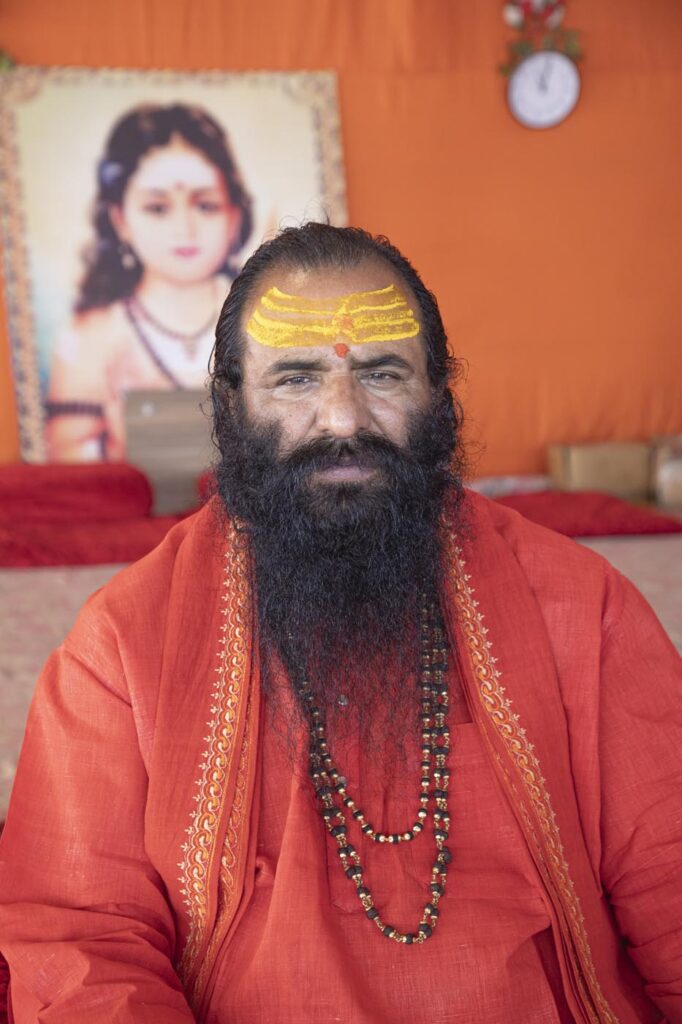
Shri Mahant Bhardwaj Giri: The most beautiful ancient tradition of Bharat is living in a joint family, which is not liked by the younger generation. It seems like a good idea to live separately, but practically there are lots of challenges. Most of the time, nuclear families have to eat from outside sources, which is absolutely not healthy. We have to bridge the gap ourselves, by going to ashrams and temples to find solace. We should pray for removal of ignorance from us.
Swami Gyananand Ji Maharaj: We find in certain cases that youth are getting disoriented, distracted from the goal and losing direction. The Internet, TV and mobile phones have many negative things. Thankfully, we are seeing youth talking about the nation, its dignity and our faith. The astonishing proportion of youth participation in Maha Kumbh is an example of this positive change. Youth are now more health conscious, more focused towards their goals.
Spirituality Versus Religion
Shri Mahant Bhardwaj Giri, chief secretary of Shri Panch Dashnam Avahan Akhara: Spirituality is for the soul as well as for the well-being of the people; whereas religion or dharma is for the entire universe. Every single entity of the universe has its own dharma. Modern lifestyle is dragging us away from our dharma, and this is a big hindrance in our spiritual upliftment. We have to maintain a balance between the two.
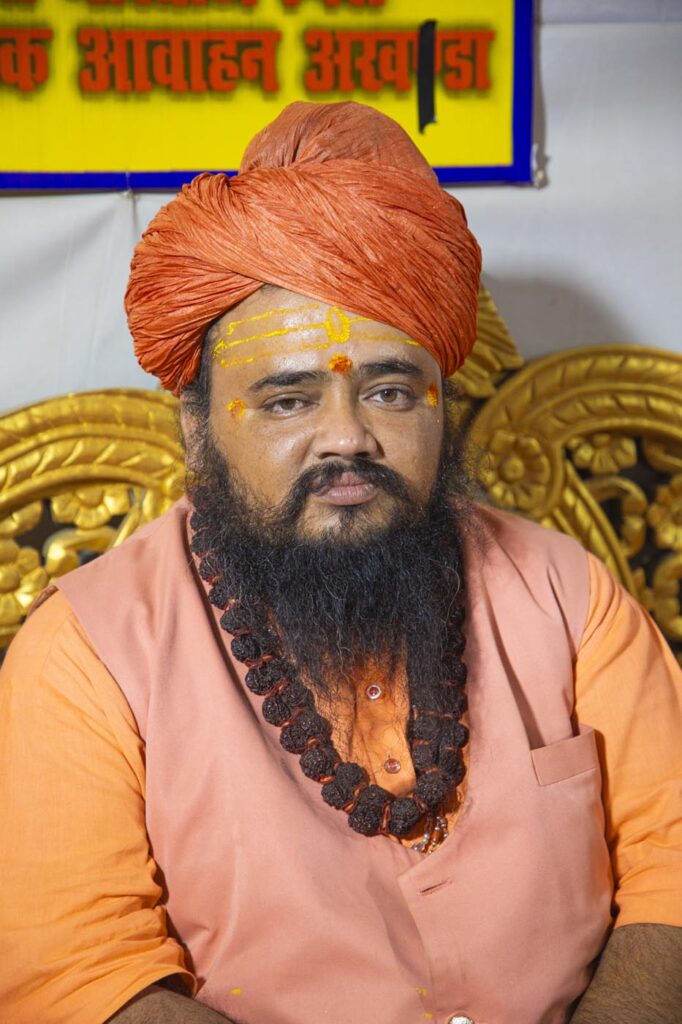
Mahant Rajendra Das: Spirituality is something personal. We pray, meditate, read, get curious about something, seek answers. This process is for Self consciousness. On a broader level, religion consists of the guidelines we follow as per our family tradition, our duties towards our own family and society. We follow many rituals, undertake pilgrimage, visit temples. We may call it religion. But listening to a wise man or a saint can be a spiritual experience.
Shri Ma Santoshi Mata: There are two sides of all of us, the vyavaharik—the practical, which we can call dharma—and parmarthik, the transcendental. Any person who wishes to fly high like a bird will have to balance these two attributes of spirituality and religion.
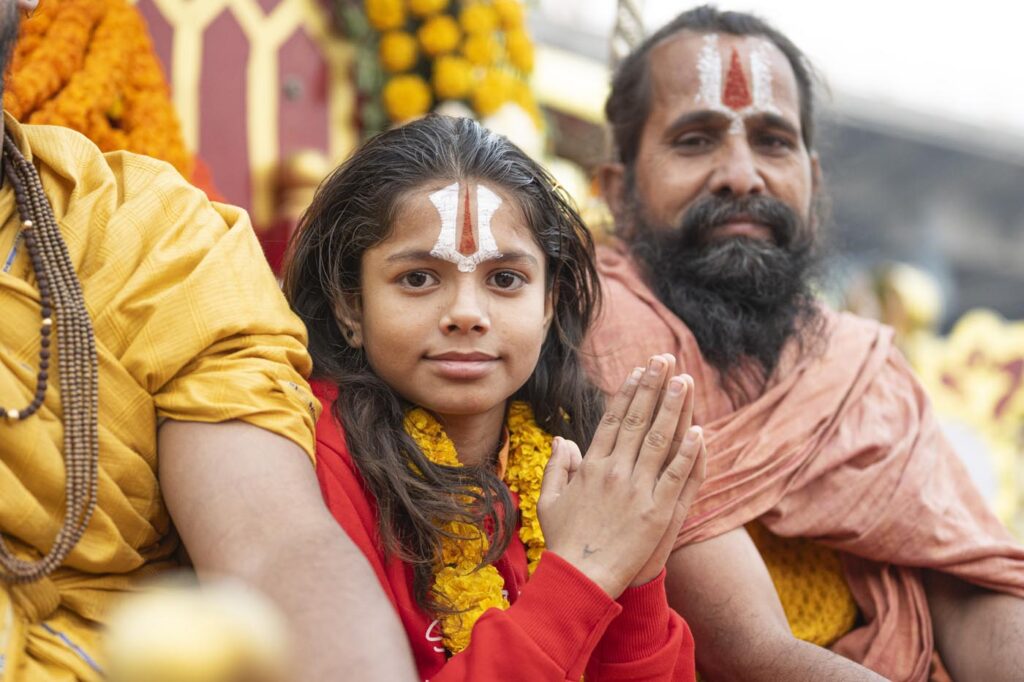
Environmental Consciousness
Shri Mahant Ravindra Puri: Our scriptures and other religious literature have put great emphasis on love for nature and environment. The science of ayurveda is based on nature. We recite mantras in reverence of the elements. The gurus and saints all lived in forests. Following dharma can solve all kinds of environmental challenges across the globe.
Yogi Sheel Nath, member of Adinath Akhara: We have to start from home, instill in our children the habits that ensure a healthy environment around us. We talk of rejecting moha, attachment. But I say we should have more moha—moha towards our relations with others, with nature and things around us. This kind of attachment will help us take more care of them. We should consider the society as our own family.
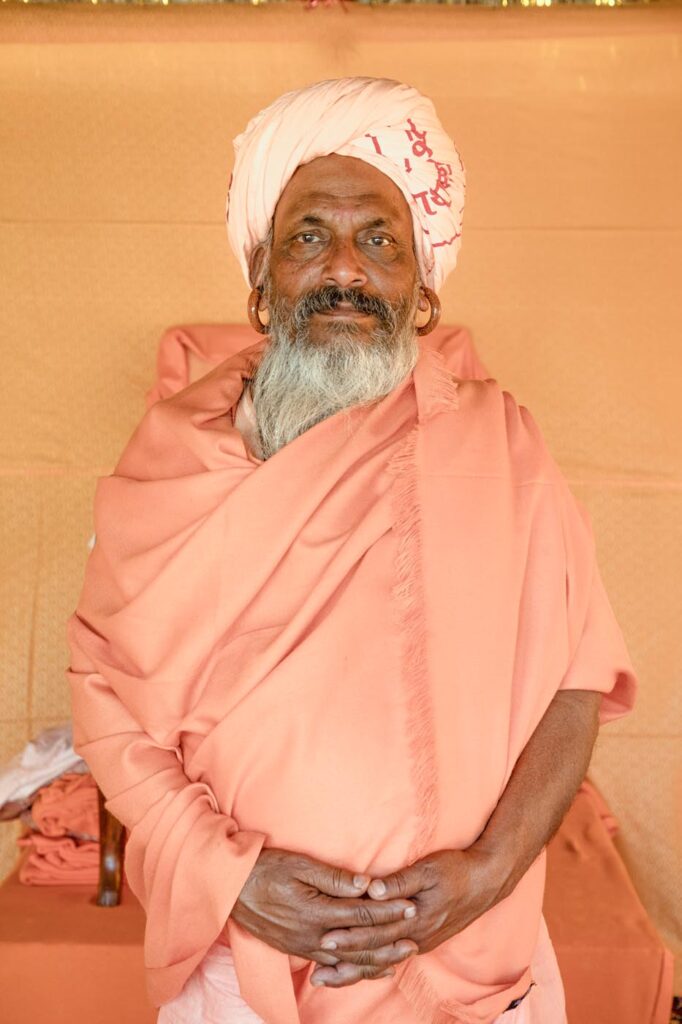
Shri Ma Santoshi Mata: The first job Lord Krishna did after reaching Vrindavan was to clean the water of Yamuna. He inspired people to protect forests after performing puja of Giriraj, the master of mountains. Sages and gurus taught us that our lives will be safe when we have well-protected forests, clean air and water. In the Vedic traditions, yagyas were performed to free the air of any pollutants.
Swami Gyananand Ji Maharaj: The five elements should remain balanced and arranged. This is the sign of good environment. In Hinduism, the five elements have been wisely and very cleverly incorporated. We do not cut trees near sacred places. Peepal (ficus) and Tulsi (basil) are very sacred to us. We have festivals dedicated to certain fruits or trees, such as amla (Indian gooseberry). Faith leads to conservation. This is one aspect of environmental consciousness. The other, according to Bhagavad Gita, is that greed leads to exploitation. Cutting of trees, polluting air and water, reduction in fertility of land happens because of our greed, when we try to snatch as much as possible from nature. There is ideological pollution in the society.
Strengthening Hindu Unity
Sri Madhukar Nath, yogi, spiritual guide and head of Satsang Foundation: The current form of Kumbh Mela was envisioned and brought to life by Adi Shankaracharya because he wanted people of all denominations to come together in one place during the Kumbh and evolve themselves in dialogue. However intersectional dialogue at the Kumbh is rare now because India has such a vast panorama of spiritual streams that some in their theory are totally opposed to the other. If only people could see that all streams lead to the ocean. Unfortunately, out of self-interest, people have dismissed that idea. They think, “I belong to a particular stream and I want only that to survive, not the others.”
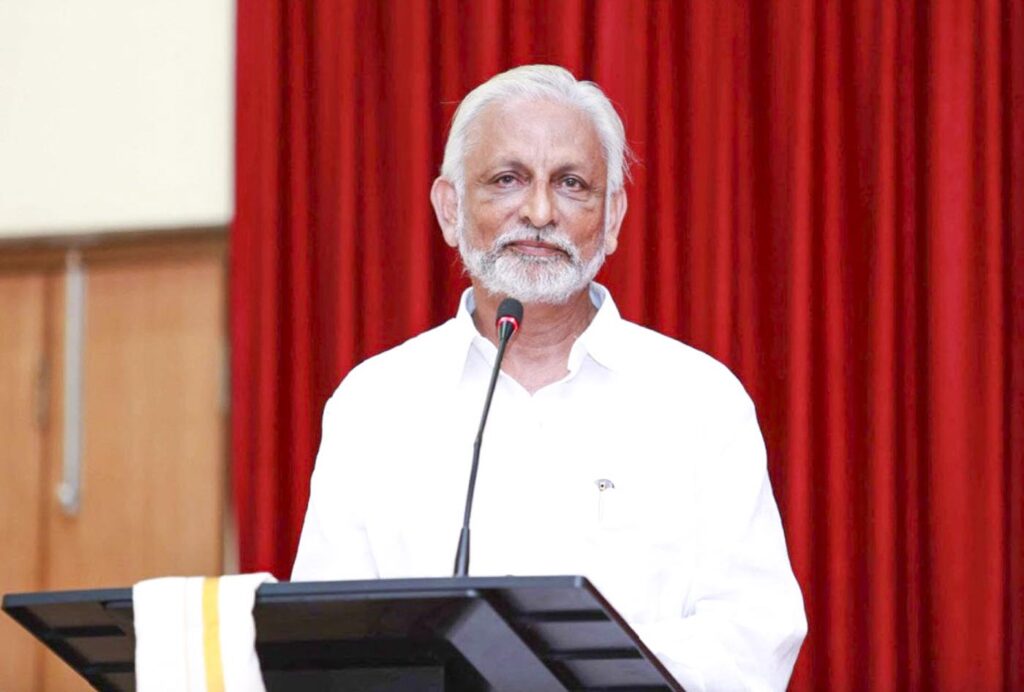
Shri Mahant Ravindra Puri: With such a great diversity in thought and practice, it is hard to keep all united. But it is so surprising to see how all of us stand together on one platform (Kumbh Mela) for Hinduism. We sit together for discourses and discussions and interact freely. Saints freely follow the principles of their spiritual paths and sects and parampara, but stand together for dharma. This is the beautiful concept of “Unity in Diversity.”
Mahant Rajendra Das: In recent times more and more people are taking and interest in Hinduism; they are more inclined towards Dharma and the spiritual aspects of it. This is an indication of a strong fraternity of Hindus. We have Mahamandaleshwars in our Akhara from Malaysia, South Africa, Mauritius and Indonesia. This shows the unity of Hinduism
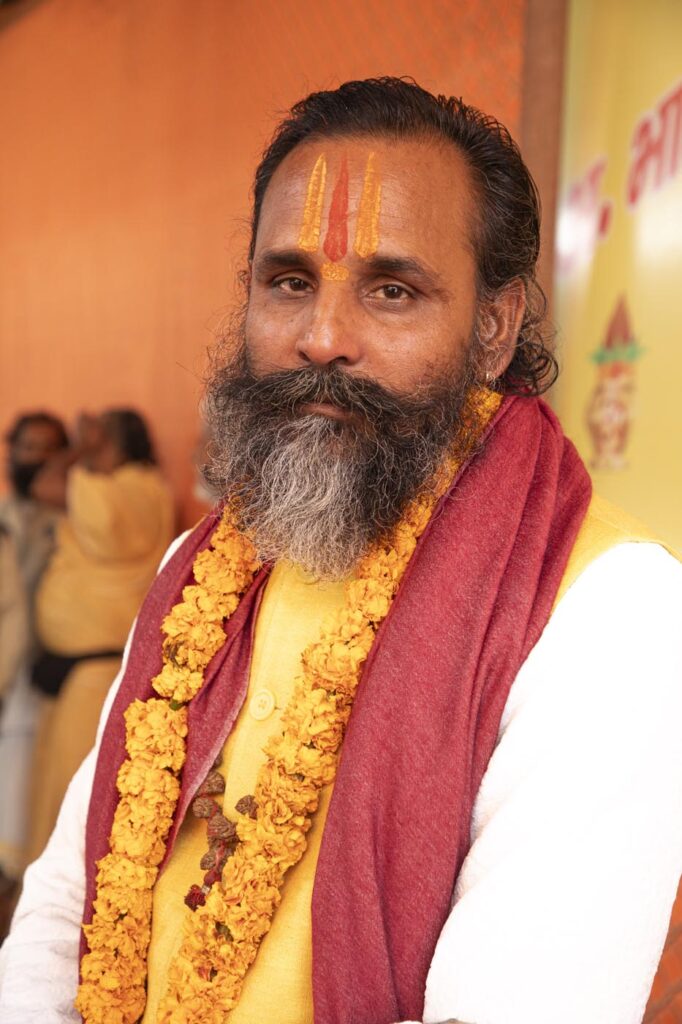
Shri Ma Santoshi Mata (left), Mahamandaleshwar of Niranjani Akhara: All of us have the freedom to follow our own sects and beliefs, but there is only one Paramsatya, the ultimate Reality. For reaching it, we should all be one. We must have a well-protected nation to reach that goal. We have to be patriotic. Aham Rahtriya Swaroopini—Devi Bhagwati says She is the nation. We must unite with the supreme power, Devi Bhagwati. According to the Vedas, the society with unity alone will progress in Kali Yuga.
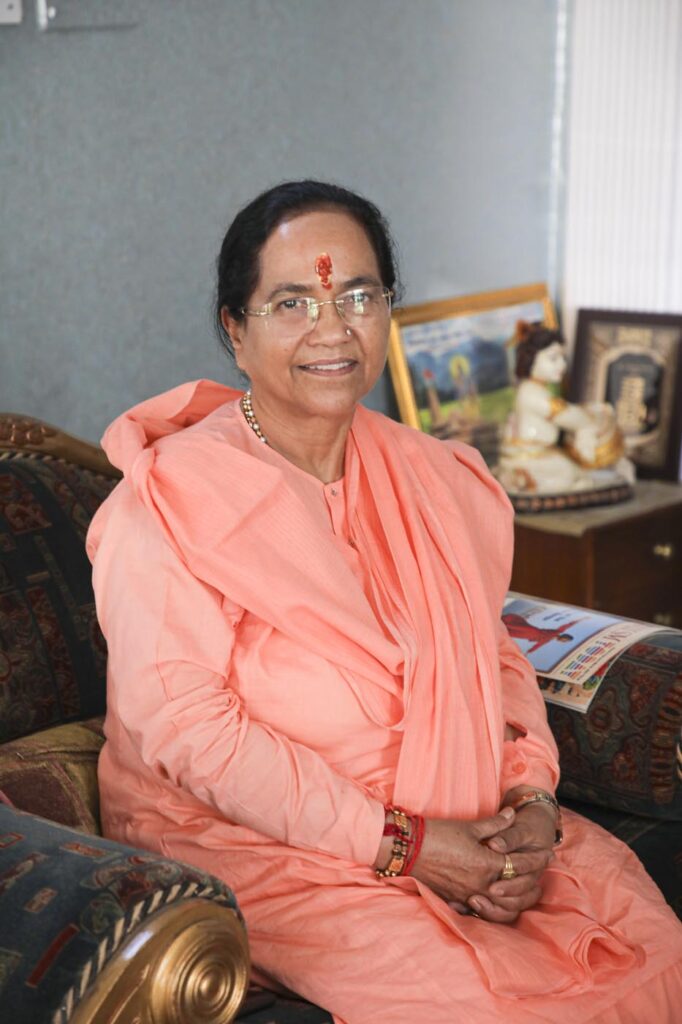
The Role of Women in Hinduism
Swami Avdheshananda Giri: Woman has stronger cells for creation than man. It is the woman who carries the child in her womb for nine months. “Matru Devo Bhava”—revere your mother as a Goddess. When the devas were counted, it was the women Deities who were counted first. The life of a household revolves around the woman. Important duties like running the household and financial management are generally in the hands of women. We believe in “Yatra Naryastu Pujyante, Ramante Tatra Devata”—devas reside in places where woman is worshiped.
Shri Mahant Ravindra Puri: In Hinduism we have smartly devised directives of behavior for men and women. In our Akharas, we have separate “Mai Wara”—the womens’ quarters. Women have been a subject of worship in the Hindu pantheon. The spread of education and exposure from outside sources are instrumental in placing women at the same stature as men. Today we have women Mahamandaleshwars, the President of the country and more.
Yogi Sheel Nath: Women have participated in Sanatana Samskriti since time immemorial. Our culture has a team of women as ministers. The finance minister of the entire world is Ma Lakshmi, the Goddess of wealth. The education minister of the entire world is Ma Saraswati, the Goddess of learning. The department of food is looked after by Ma Annapurna. The women and child welfare department is in the hands of Mata Parvati and the ministry of defence is looked after by Ma Kali and Durga! Similarly, women should efficiently look after various departments of their own homes like finance, food, education and health. Today we have women officers in the police, army, administrative services. They even fly fighter jets. Women should live with dignity, should live like Lakshmi and Durga. And when need be, they should take up the role of Ma Kali!
Shri Ma Santoshi Mata: In the Vedic era, women were an object of respect. She was considered as Shakti Swarupa, the symbol of power. In the medieval times, when we were invaded by outsiders, it was a bad phase of life for the women of India. It was just during the times of the invaders, women were not kept in the forefront. Women themselves must find the real woman in them.
Swami Gyananand Ji Maharaj: One of the main pillars of our faith is woman. If a woman is well aware of the practice of religion and spiritual life, it is directly going to affect the entire family. One educated woman means one educated and awakened family. The path to be followed by our next generation is decided by the woman of the house.
Maintaining Hindu Identity Wherever We Live
Swami Avdheshananda Giri: We should keep our rituals alive. Hinduism was never a threat to anybody. People have communal, territorial differences among them. Hindus never tried to convert other countries. Everybody has the right to maintain his affinities. Proselytizers converting others think they are superior. People were forced to change their ethnic identity, their clothes and languages. Names of cities and countries were changed. Indulging in such practices cannot alter the inherent character of a society, cannot make people a better society. Conversion is the biggest fraud on our planet.
Sri Madhukar Nath: Those who have already settled abroad and have a good understanding of Hinduism must be proactive in conversing with newly arriving Hindus. They should not clash with the religion of the place where they live. You do your own. Don’t find fault with others. I have many centers abroad and am happy to mostly see young people there. They are open to understanding. Some are fed up with the way religion was practiced by their parents and want to know the truth. When you show them that this is a treasure trove which you can dive in freely and choose from, they are delighted.
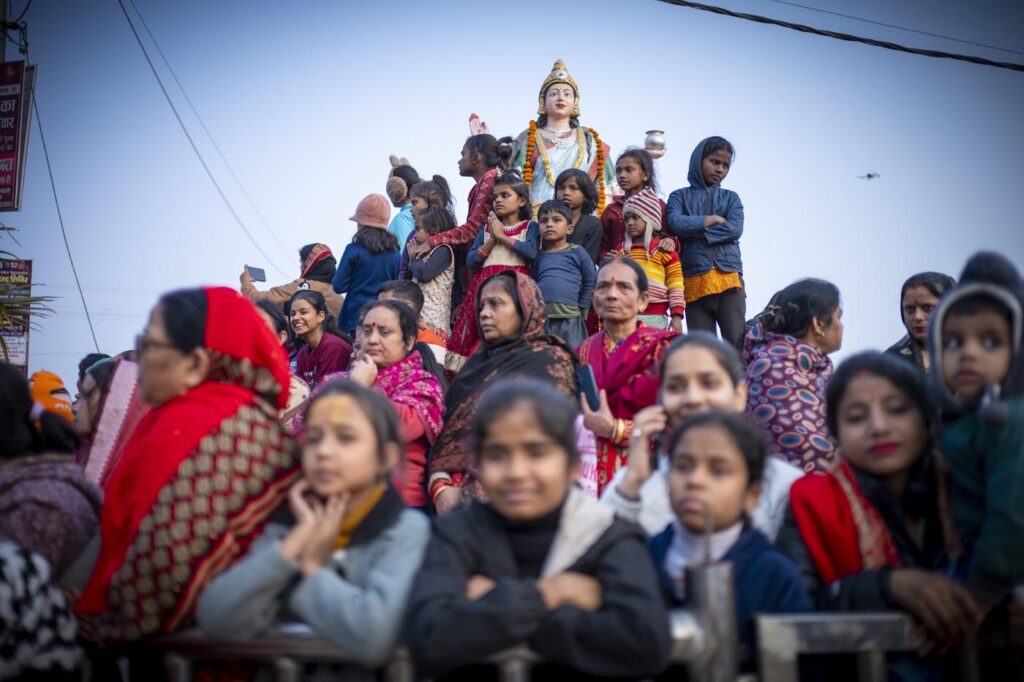
Yogi Sheel Nath: The key focus should be our own conduct. There is only one God, with innumerable manifestations. Each manifestation has the same power and importance. It is like a lamp lit by the fire of another lamp. Once lit, it becomes the same fire, with the same strength of energy and light. Similarly if a person sees Brahma, he also becomes Brahma, like the fire of the lamp.
Shri Ma Santoshi Mata: Deprived people are distracted easily from the path of dharma. I have been working in Kalahandi region of the state of Odisha. Even the basic needs of people are not fulfilled there. They are easily lured into conversion to other religions. Society must bring such people back to the mainstream by providing assistance. We must show them the way to lead a self-reliant life instead of teaching them to live on charity.
Challenges to Hinduism from Academia
Shri Mahant Bhardwaj Giri: The West comes to India to benefit from our knowledge about the Sanatan system, our lifestyle and our spiritual superiority. They have had enough of materialism. They find peace and solace in Bharat. They are able to feel the cosmic energy of Mahakumbh and are often overwhelmed by the enormity of things in our great nation. Then they realize the power of Sanatan Dharma.
Swami Avdheshananda Giri: The wrong narratives from academia about Hindu philosophy are a big challenge, presenting a distorted picture of our religion. We are discussing how we can project Hinduism in the right perspective. Attacks on our lifestyle, culture and scripture have continued for the last 1,500 years. There are thousands of articles on different facets of Hinduism in the website called Hindupedia. I am sure the time will come when people will know the truth and accept Hinduism in its true spirit. Academia is targeting us in new ways. They have tried to split us by creating baseless differences such as between the people from northern India and from the South. We grew up as one entity, as one society, with similar social and religious affinities.
The Role of Meditation and Yoga in Modern Life
Swami Gyananand Ji Maharaj, founder, Shri Krishna Kripa Seva Samiti: The situation is a little complex, a dilemma. People are promoting themselves in their own ways. There is no harm in having a commercial angle to the promotion of yoga and meditation. But please don’t consider monetary gain above your duty. Our cultural values have to be the source of inspiration for a common man, and this is the primary duty of preachers, teachers and trainers. If we are sincere and strive to practice the nuances of yoga and meditation seriously, then we cannot go wrong in selection of our guru. We must not follow anyone blindly.
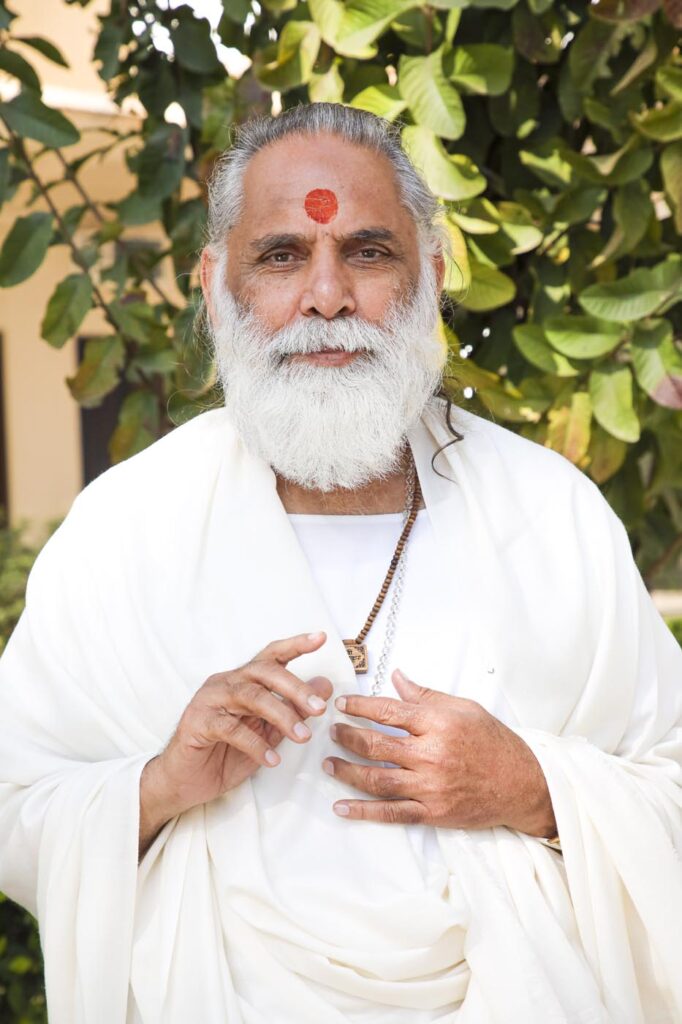
Technology for Spreading Hindu Teachings
Swami Avdheshananda Giri: We always respect technology and welcome the use of gadgets. Our dharma is spreading to the corners of the Earth with advancements in the field of telecommunication. It is easier for people now to understand the concept of dharma and practice it. I use social platforms myself. I am on X, previously called Twitter. There are 465 million users of the Indian telecommunication company Jio and 385 million users of Airtel network. I have heard that X is collaborating with these companies in India. This will further strengthen our network and reach of Hinduism.
Shri Mahant Ravindra Puri: As a young saint, I remember carrying a bag full of books. Now I have Google with me. There is a plethora of books and literature available on the Internet. Scans of innumerable rare manuscripts are now within easy reach of scholars. Technology and social media has taken the Mahakumbh to the remotest corners of planet Earth. Millions of people watch the religious programs of katha and religious discourses on specialized TV channels and on platforms like Youtube.
Swami Gyananand Ji Maharaj: We have to convince people that Hinduism is a system of generosity and goodwill. Hinduism’s philosophy talks about the welfare of the entire humanity. We must help people to see that no other religion or ideology finds their good by doing good to others. Other religions believe in their own expansion and removal of other beliefs and ideologies.
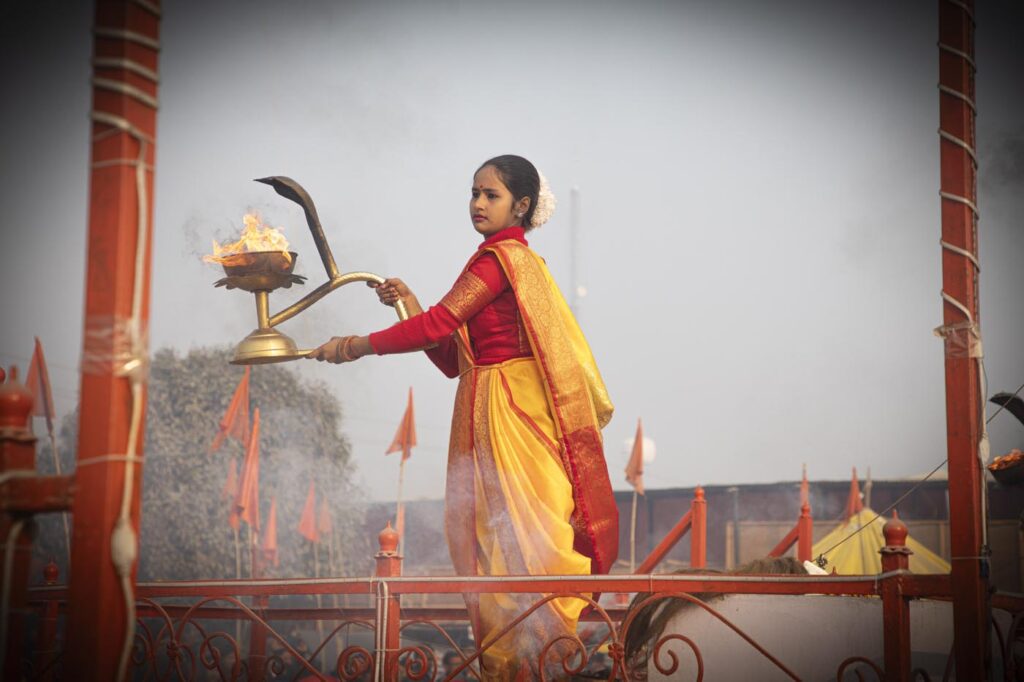
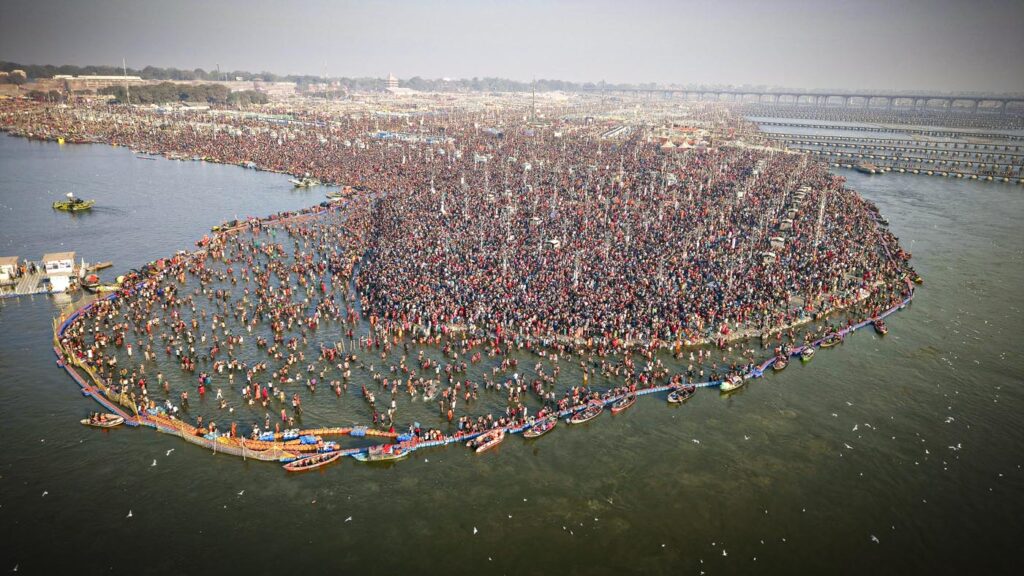
Thank you for adding the share buttons. Om Namah Shivaya
It’s impressive that youunger generation have rising intrest in our culture and retual. Thanks for detailed insight about kumbh mela.